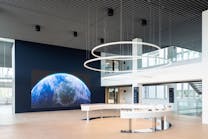LEDs Magazine Virtual Event, Day 2 — Talks center on industry transformation, fine-tuning healthy lighting
LEDs Magazine recently launched its first all-online event, a two-day conference on Sept. 29‒30 titled “Renaissance of light quality: SSL industry swaps focus from efficiency to architecture.”
On Sept. 29, Day 1 of the program, a theme unfolded of bringing together the individual characteristics of light quality to build the optimum experience of light.
LED and solid-state lighting (SSL) professionals and commercial end users arrived on the platform on Day 2, Sept. 30, to learn how a new generation of lighting components and controls can instill SSL systems with the ability to produce a healthier quality of light, using evidence-backed research to develop application-appropriate technology. They also learned how products become part of the built environment and change how occupants feel and behave in a space. Finally, the Closing Plenary panel turned some heavy-hitting business issues inside out and debated what the lighting industry needs to change in order to align its processes with the leading-edge products it offers.
In the first session of Day 2, “Advanced luminaire design and application,” consultants at industrial design firm Billings Jackson Design dove into the challenges of transforming architecture with light. Noting that “design is becoming a more and more important element in everyday objects,” partner Eoin Billings summarized how many modern structures, indoor spaces, and outdoor features have required the project team to consider built-in solutions to unique design problems. His cohort Duncan Jackson first framed the sentiment that was later echoed by LED Linear USA director of product management and manufacturing Basar Erdener: “How the light affects the environment rather than the object is bringing into focus the architectural imperative [across many scenarios].”
From cove lighting components built into custom-shaped gypsum units to tiny lenses that enable extremely slim linear lighting and more, all three presenters gave form to the idea that contemporary design with SSL opens up opportunities for truly novel integration of light with decorative features, walls, ceilings, and other surfaces for illumination that is functional, pleasing, and expressive – all while creating a positive impact and healthier experience when light is done right.
Turning to the ability to impact human wellbeing with quality, controllable lighting, UL’s Adam Lilien and the US General Services Administration’s (GSA’s) Bryan Steverson approached the topic from design guidance and evidence-backed implementation points of view. Lilien, who also serves on the UL circadian lighting task force publishing UL DG (Design Guideline) 24480, outlined what the DG is and what it isn’t to dispel confusion about its purpose. He explained, “When the industry isn’t ready to adopt a standard, other measures are offered, such as outlines of investigation, recommended practices, design guidelines, field evaluations,” among other resources. UL, he summarized, is looking to develop practices that inform lighting professionals on “how to deliver predictable results.”
With regard to those results, Lilien observed, the collaborations between scientists at the Lighting Research Center and the GSA have produced the kind of applicable data that allowed UL to launch the task force, prepare an initial proposed DG, request and implement industry comments, and finalize the DG that is targeted to designs that promote circadian entrainment for day-active people. This includes a recommendation to deliver light with a Circadian Stimulus (CS) of at least 0.3 during the day and <0.1 at night. You can learn more about the CS metric in an article by the LRC’s Allison Thayer, Part 1 of a series.
Steverson then presented findings from the long-term partner studies that were done at GSA and other federal offices, and asked in his presentation how industry stakeholders can shift focus from risk avoidance to health promotion. He cited data from the Centers for Disease Control and Prevention (CDC) on the impacts of insufficient sleep from a business analytics perspective. The US alone, he commented, loses about 1.23 million collective working days per year due to sleep loss in the population. He ran through the study phases and how data was applied after each collection to the next phase, remarking that the latest studies showed morning blue-rich light and afternoon red-rich light improved test scores on subjective daytime sleepiness, vitality, and the ability to rise and sleep on a cycle more in line with the natural day-night cycle.
Speakers then moved from concepts to systems integration for tunable light. Tom Jory, vice president of illumination marketing at LED supplier Luminus, emphasized that although the SSL sector is working off of the most current circadian and healthy lighting data, stakeholders must continue to learn and evolve product development to improve indoor light with each iteration. He offered a look at the various concepts of healthy light, and the guidance and metrics available for product developers and system designers.
Co-presenter Ray Chock of power-electronics consultancy Cuvée Systems further explained that a simplified approach to design is one that specifies compatible components already engineered to deliver tunable light, deep dimming, and smooth, flicker-free operation (see the Day 1 wrap-up report for more on how flicker impairs light quality in the built environment). Jory and Chock provided some background on the WELL Building standard and how its lighting requirements underpin the need for tunability and granular but user-friendly controls in buildings. They tossed the baton back and forth to give an overview of controls and power options, and ways to prime the system to maximize precisely-tuned light output and longevity.
Finally — and unfortunately — this writer does not feel that we can do the Closing Plenary justice in an event overview such as this. Announced a few weeks back, the session format was a panel discussion combined with leader Michael Kershner of Innovative Lighting Consultants providing insights on design and supply chain process and operations improvements. As we mentioned in the prior linked coverage, Kershner’s objective in structuring the panel and selecting the participants was to broach the lighting industry’s fear of change — the biggest obstacle to LED and SSL sector innovation. Panelists Chip Israel (CEO and founder of Lighting Design Alliance), Sero Cardamone (senior vice president, sales, Acuity Brands), and Chuck Swoboda (president of Cape Point Advisors and innovator-in-residence at Marquette University) tackled the pain points and disruptions needed to move the lighting industry forward.
Kershner’s stated desire for the lighting industry was to promote “the transformative nature of better experience that the customer will choose.” The way to do this, he claimed, was to create more operational efficiency, leverage automation, and position the project outcome as an experience of value.
Early in the conversation, Swoboda observed that “innovation eventually finds the inefficiency in all markets,” which brings into focus products and processes that need to be phased out to better serve the customer and improve companies’ bottom lines.
Discussion ensued about available computer-based design and specification tools, which are intended to automate the process to some degree. However, Israel said, “At the end of the day, we need creativity and that’s really hard to get out of a computer,” and that the consulting process between design/lighting experts and the customer can be innovative in considering the human element.
Following was a rousing dialog and debate about perceptions of commoditization, competition, the changing roles of distributors, and pricing transparency.
The audience lamented the lack of more time to explore additional inquiry. LEDs Magazine is considering ways in which to expand this discussion. Look for more from us on this quality of light virtual event and visit the on-demand archive if you were unable to attend any of the presentations.
For up-to-the-minute LED and SSL updates, why not follow us on Twitter? You’ll find curated content and commentary, as well as information on industry events, webcasts, and surveys on our LinkedIn Company Page and our Facebook page.

Carrie Meadows | Editor-in-Chief, LEDs Magazine
Carrie Meadows has more than 20 years of experience in the publishing and media industry. She worked with the PennWell Technology Group for more than 17 years, having been part of the editorial staff at Solid State Technology, Microlithography World, Lightwave, Portable Design, CleanRooms, Laser Focus World, and Vision Systems Design before the group was acquired by current parent company Endeavor Business Media.
Meadows has received finalist recognition for LEDs Magazine in the FOLIO Eddie Awards, and has volunteered as a judge on several B2B editorial awards committees. She received a BA in English literature from Saint Anselm College, and earned thesis honors in the college's Geisel Library. Without the patience to sit down and write a book of her own, she has gladly undertaken the role of editor for the writings of friends and family.
Meadows enjoys living in the beautiful but sometimes unpredictable four seasons of the New England region, volunteering with an animal shelter, reading (of course), and walking with friends and extended "dog family" in her spare time.





